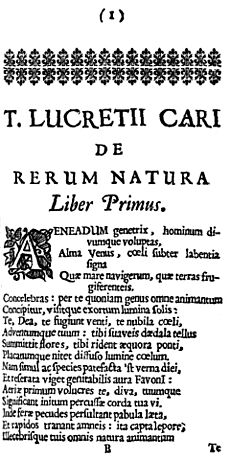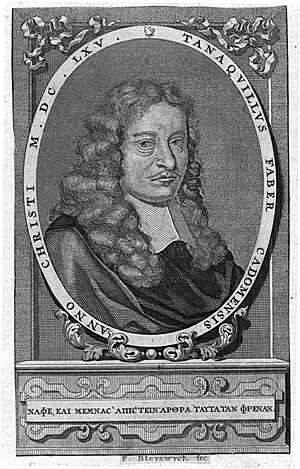Tanneguy Le Fèvre facts for kids
Tanneguy Le Fèvre (born 1615, died 1672) was a smart French expert in ancient Greek and Roman studies. He was also known as Tanaquil Faber. He wrote many books and translated lots of old texts. What was special about him for his time? He taught his daughter, Anne Dacier, Greek and Latin. She later became a very famous scholar and translator herself, known as Madame Dacier.
His Life and Important Work

Tanneguy Le Fèvre was born in a town called Caen in France. After he finished his studies in Paris, a very powerful leader named Cardinal Richelieu gave him an important job. Le Fèvre became an inspector for the printing press at the Louvre. The Louvre is now a famous museum, but back then it was a royal palace.
After Cardinal Richelieu passed away, Le Fèvre left Paris. He joined the Reformed Church, which was a Protestant group. In 1651, he became a professor at the Academy of Saumur. He was a very successful teacher there for almost twenty years.
Later, Le Fèvre started having health problems. He also had some disagreements with the church leaders, called the consistory. Because of these issues, he decided to leave his teaching job. Many other universities wanted him to come and teach for them. He had even agreed to a job at the Heidelberg in Germany. But he sadly died suddenly before he could move.
One of his children, Anne, grew up to be a brilliant expert in old languages. She became the famous classical scholar and translator known as Madame Dacier.
What Books Did He Write?
Tanneguy Le Fèvre was a very educated man. He knew a lot about ancient Greek and Latin writings. He helped publish new versions of many books by Greek and Latin authors. These included famous writers like Longinus, Anacreon, Sappho, Virgil, Horace, and Lucretius.
He also wrote some important books of his own. One was called Les Vies des poètes Grecs, which means Lives of the Greek Poets. He published this in 1665. Another important book was Méthode pour commencer les humanités Grecques et latines. This book was a guide for learning Greek and Latin. It was so popular that it was printed again in 1731. Parts of it were even made into English guides, like A Compendious Way of Teaching Ancient and Modern Languages in 1750. He also wrote Epistolae Criticae in 1659, which were critical letters.
Sources


